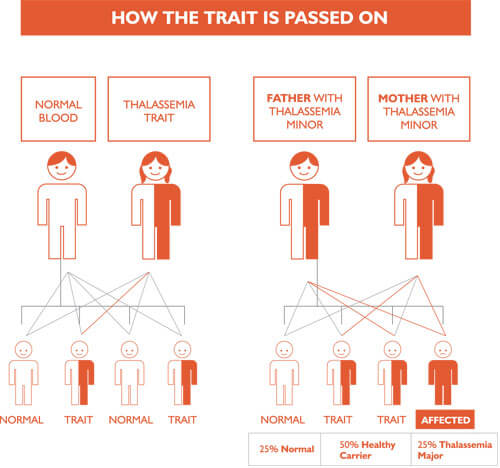Thalassaemia Trait Testing
Finding out if you have the genetic trait for Thalassaemia begins by determining the size of your red blood cells.
If you have a routine blood test known as a complete blood count, or CBC, already on file at your doctor’s office, ask your doctor to look at the Mean Corpuscular Volume, or MCV. The MCV reading determines the size of your red blood cells. For adults, if the MCV reading is less than 75 and you are not iron deficient, you may be a trait carrier. For children, the MCV reading may be lower and varies according to their age.
If your MCV reading indicates that you may have the Thalassaemia trait, your doctor should then perform additional tests to confirm that you have the Thalassaemia trait and to determine what kind.
Although the MCV reading is a good indicator of whether a person may have either the alpha or the beta Thalassaemia trait. Finding out or certain if you have either trait involves additional tests.
Special tests called haemoglobin electrophoresis and quantitation of haemoglobin A2 and haemoglobin F are a reliable way of determining whether or not a person has a trait for beta Thalassaemia (beta Thalassaemia minor). These tests are available at most large hospitals and clinics.
Testing for alpha Thalassaemia trait (alpha Thalassaemia minor) is usually done by a process of exclusion; people who have low MCV (not due to iron deficiency), a normal haemoglobin electrophoresis, quantitative haemoglobin A2 and quantitative haemoglobin F, and are of the appropriate ethnic origin are presumed to have alpha Thalassaemia minor.
In some circumstances, more definitive “molecular” testing is performed to determine the presence or absence of Thalassaemia trait. As these genetic tests are developed further, they will be used more widely to test for Thalassaemia trait.
Remember that the first step to finding out if you have the Thalassaemia trait is easy. Just call your doctor and ask him or her to check your MCV reading. Testing for Thalassaemia can be done at most hospitals. When you go in for your test bring this book with you to share with your doctor.

Here’s how it’s typically approached:
Complete Blood Count (CBC): This is often the initial test used to screen for thalassemia traits. It measures the hemoglobin levels and the size and number of red blood cells. Individuals with thalassemia traits may have slightly lower hemoglobin levels and smaller red blood cells compared to those without the trait.
Hemoglobin Electrophoresis: This test helps to identify the specific types of hemoglobin present in the blood. Individuals with thalassemia traits may show a mild imbalance in the types of hemoglobin, which can help differentiate it from other types of anemia.
Genetic Testing: Genetic testing can confirm the presence of thalassemia traits by identifying specific genetic mutations associated with the disorder. This is particularly useful for carriers who may not show significant symptoms but can pass the trait on to their children.
Family History: Often, a detailed family history is important because thalassemia traits are inherited. If one or both parents are known carriers, their children have a higher risk of inheriting thalassemia.
The Parents’ Association Thalassemic is the national non –profit health organization dedicated to serving patients afflicted with various forms of Thalassaemia most notably the major forms of this generic blood disease

